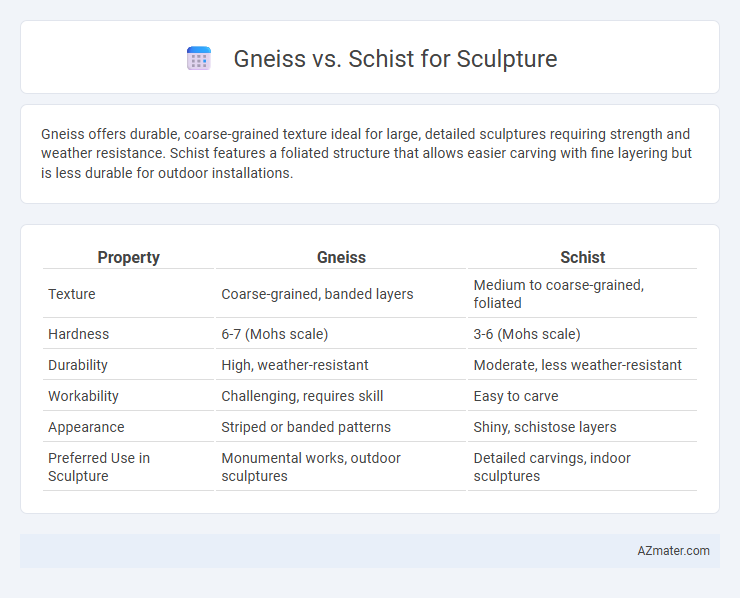Gneiss offers durable, coarse-grained texture ideal for large, detailed sculptures requiring strength and weather resistance. Schist features a foliated structure that allows easier carving with fine layering but is less durable for outdoor installations.
Table of Comparison
| Property | Gneiss | Schist |
|---|---|---|
| Texture | Coarse-grained, banded layers | Medium to coarse-grained, foliated |
| Hardness | 6-7 (Mohs scale) | 3-6 (Mohs scale) |
| Durability | High, weather-resistant | Moderate, less weather-resistant |
| Workability | Challenging, requires skill | Easy to carve |
| Appearance | Striped or banded patterns | Shiny, schistose layers |
| Preferred Use in Sculpture | Monumental works, outdoor sculptures | Detailed carvings, indoor sculptures |
Introduction to Gneiss and Schist
Gneiss and schist are both metamorphic rocks valued for sculpture due to their unique textures and durability. Gneiss features a banded or foliated appearance with alternating layers of quartz, feldspar, and mica, providing a robust and visually striking medium for artists. Schist, characterized by its coarse grain and high mica content, offers greater flexibility and ease of carving, making it suitable for detailed sculptural work.
Geological Formation and Composition
Gneiss and schist exhibit distinct geological formations that influence their suitability for sculpture. Gneiss forms through high-grade metamorphism, characterized by alternating light and dark mineral bands primarily composed of quartz, feldspar, and mica. Schist results from medium-grade metamorphism with a pronounced foliated texture dominated by abundant mica minerals, providing a softer, more workable material for detailed sculptural work.
Physical Characteristics: Texture and Appearance
Gneiss features a coarse, banded texture with alternating light and dark mineral layers, offering a visually striking and durable surface ideal for large-scale sculptures. Schist exhibits a foliated texture with visible mica flakes, giving it a shimmering, flaky appearance that allows for intricate detailing but is generally softer and less durable than gneiss. The choice between gneiss and schist depends on the desired sculpture's finish and durability, with gneiss favored for strength and bold patterns, while schist suits finely detailed, lighter works.
Workability and Carving Properties
Gneiss offers moderate workability with a coarse-grained texture that can challenge detailed carving but provides durability for larger sculptures. Schist, characterized by its foliated structure, allows easier splitting and finer carvings due to its softer, layered minerals. Sculptors often prefer schist for intricate designs while gneiss is favored for robust, monumental works due to its toughness.
Durability and Weather Resistance
Gneiss offers superior durability and weather resistance compared to schist due to its coarse-grained texture and high quartz content, making it more suitable for outdoor sculptures exposed to harsh environmental conditions. Schist, characterized by its foliated structure and micaceous minerals, tends to split and erode more easily, limiting its longevity in weather-exposed sculptures. Choosing gneiss over schist ensures enhanced structural integrity and minimal weathering effects for long-lasting sculptural works.
Color Variations and Artistic Appeal
Gneiss offers a diverse palette of colors including shades of gray, pink, and white, creating striking banded patterns that enhance the visual appeal of sculptures. Schist, characterized by its foliated texture and often metallic sheen from mica content, presents rich earth tones like green, brown, and silver, adding depth and dynamic reflectivity to artistic works. The choice between Gneiss and Schist depends on the desired aesthetic effect, with Gneiss providing bold, linear color contrasts and Schist offering a more textured, shimmering surface.
Weight and Handling Considerations
Gneiss, with its coarse-grained texture and higher density, tends to be heavier and more challenging to carve compared to schist, which has a foliated structure that allows for easier splitting and reduced weight. Schist's layered composition facilitates handling and precision in sculpting, making it well-suited for detailed work where lighter material is beneficial. Weight differences between gneiss and schist significantly impact transportation and support requirements for large sculptures.
Suitability for Indoor vs Outdoor Sculptures
Gneiss offers superior durability and weather resistance, making it more suitable for outdoor sculptures exposed to varying environmental conditions. Schist, characterized by its foliated texture and relative softness, is better suited for detailed indoor sculptures where controlled conditions prevent weathering and preserve fine details. Choosing between gneiss and schist depends on the sculpture's exposure, with gneiss favored for longevity outdoors and schist preferred for intricate indoor artistry.
Historical and Contemporary Uses in Sculpture
Gneiss and schist, both metamorphic stones, have been historically favored in sculpture due to their distinct textures and durability; gneiss's banded appearance offers a striking aesthetic, while schist's foliated structure allows for detailed carving. Ancient civilizations utilized gneiss for large monumental sculptures and architectural elements, leveraging its hardness, whereas schist was preferred for intricate relief work and smaller statues. Contemporary sculptors continue to exploit gneiss for outdoor installations requiring weather resistance, and schist for expressive, textured art pieces that emphasize its layered composition.
Choosing Between Gneiss and Schist for Your Artwork
Gneiss offers a fine-grained texture and high durability, making it ideal for detailed sculptures that require structural strength and weather resistance. Schist exhibits pronounced foliation and a softer composition, allowing for easier carving and intricate designs but may be less suitable for outdoor pieces due to its tendency to split along layers. When choosing between gneiss and schist for your artwork, prioritize gneiss for longevity and structural integrity, while selecting schist for projects emphasizing texture and elaborate detailing.

Infographic: Gneiss vs Schist for Sculpture
 azmater.com
azmater.com